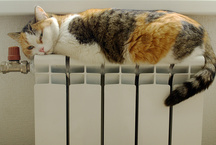Other parts:
1. Choose an aluminum radiator
2. Why aluminum radiator?
3. 8 best aluminum heating radiators
4. 10 most typical reviews of aluminum radiators
5. Installation and connection of aluminum radiator
The main purpose of this small study is to assist those who decide to upgrade their heating system. Those who have already decided to install aluminum radiators in a house, apartment or workplace, but do not yet have full information about them. Let's try together to figure out how not to get into a mess, choosing new batteries instead of outdated equipment, which technical specifications to focus on.
.jpg)
Photo: trubo-service.ru
Let's start with the fact that aluminum radiators are manufactured using two different technologies:
- extrusion method
- casting method.
What is extrusion? Extruders are special forms - a matrix through which aluminum alloy is pressed under pressure. The resulting long billet cut after cooling into separate parts. And the top and bottom parts are attached to the hollow profiles later. Finished products have a record low weight. They are much easier than steel or copper-aluminum radiators. Easier than cast models from the same aluminum. Corresponds to the weight and attractive price.
Unfortunately, the obvious advantages of extrusion models end there. Such radiators wear out faster and have worse thermal performance in comparison with their molded counterparts. The working pressure for which extrusion models are designed is, on average, 25% lower than that of cast ones. Therefore, it is beneficial and safe to install such batteries in independent heating systems with adjustable pressure.
Working pressure is one of the main characteristics, indicating the pressure at which in the heating system permanent operation of the radiator can occur. Another important characteristic is the pressing pressure. It exceeds working in 1.5, and even 2 times. This indicates the strength of the water hammer that the heater can withstand under extreme load on the system.
It is fair to say that in individual homes, you can safely use equipment made of aluminum, designed for a working pressure of up to 12 atmospheres. For apartments in urban high-rise buildings, it is better to choose those brands whose working pressure is 16 atm. and above, and pressure testing - at least 24 atm. The strength of the radiator is directly related to its reliability and trouble-free operation.
The manufacturer may indicate pressure in atmospheres, bars or megapascals. It should be remembered that 1 atm. = 1 bar = 0.1 MPa. For example, if the operating pressure is indicated 1.6 mPa, it means 16 atm. or 16 bar.
Having determined the pressure, pay attention to the dimensions. The main characteristic is the center distance. This distance is measured from the center of the upper to the center of the lower collector. So, if it is 500 mm, this does not mean that this is the real height of the device. With the standard half-meter center distance, we get the section size vertically equal to 560-590 mm. The overall height of the aluminum radiator, the center distance of which is 350 mm, will be within 450 mm.
.jpg)
What matters is the depth and width of the sections, as well as their number. To determine the optimal dimensions of the battery, it is necessary to know the exact dimensions of the so-called "seat" on which the device will be installed. Based on the layout and area of the room, the sections are calculated by quantity. In cast radiators, selecting the number of sections or finished blocks of 2-3 sections in each can adjust the total length of the battery.In the case of an extrusion model, there is no possibility to influence its size.
Finally - about the most important for the consumer quality of heating devices - heat transfer or power. Its high performance is one of the main advantages of aluminum radiators. This parameter is measured in watts. In cast models, heat transfer is indicated for one section. For each section with an inter-axial distance of 500 mm, the heat output is approximately 100-150 W. By multiplying this value by the planned number of sections, we obtain the total heat transfer from the radiator.
Other parts:
1. Choose an aluminum radiator
2. Why aluminum radiator?
3. 10 best aluminum heating radiators
4. 10 most typical reviews of aluminum radiators
5. Installation and connection of aluminum radiator

